Day 28
April 12
 Nonce Form
Nonce Form
Today is the final day of my series. It’s been great fun creating these pages, and the series will continue on the Marin Poetry Center Website, initially hosted by Rebecca Foust.
This week includes Passover and Easter in this strange world of social distance. It’s no longer a novelty, but the new normal. We have remote seders and church services, online poetry readings, online meetings with families. In much the same way that this has become the new normal, all poetic forms started as something made up by a particular poet to express something. Sometimes the form catches on and we get the sonnet, the villanelle, the sestina, the great library of poetic form we all take for granted. Nonce poetry, forms made up to express a particular need for one poem, is not new. Form is a living, morphing engine of creation; the syllabic, the duplex, the golden shovel, the cento, the erasure, the gigans, the rhopalic are all examples of recent forms that enliven the poetic landscape. The constraints of ouilpo are a way to force innovation into your writing. So today is about creating your own form.
Poem: One very recent example is the Burning Haibun, a form that combines haibun and erasure.
Craft: This discussion on the form uses the above poem as an example, and here is a more general overview of writing new forms.
Prompt: Make up a form! Do you have something you’ve been trying to write, but haven’t been able to? Try imposing some formal constraint on yourself. As an example, I was asked to write a poem for an updated Passover Hagaddah. I was stymied until I tried a variation on the Golden Shovel form. I took a poem I loved and simply created a poem of the same length, using many of the words of the original. This form doesn’t have a name, I can’t think what to call it, I welcome your suggestions. I’ll put the original and the new poem here. You might want to try something like this.
Envy of Other People’s Poems
In one version of the legend the sirens couldn’t sing.
It was only a sailor’s story that they could.
So Odysseus, lashed to the mast, was harrowed
By a music that he didn’t hear—plungings of the sea,
Wind-sheer, the off-shore hunger of the birds—
And the mute women gathering kelp for garden mulch
Seeing him strain against the cordage, seeing
The awful longing in his eyes, are changed forever
On their rocky waste of island by their imagination
Of his imagination of the song they didn’t sing.
Robert Hass
The Refugee’s Song
for Robert Hass
Tonight the legend reignites, one version
Of the story the displaced carry, a song we
Couldn’t sing, in Egypt, mute,
Straining against the cordage of our bondage.
An awful longing to flee possessed us,
as an awful longing drives all who risk
The plungings of the sea, wind-sheer,
Hunger, the rocky waste of desert. Imagining
We could be changed forever, free to sing
the song we couldn’t sing.
Journal: Mezzo Cammin welcomes submissions of poetry that pays particular consideration to form. Poems in structured forms are especially welcome, but poems that use form in interesting and experimental ways are also encouraged. You can submit four-six unpublished poems as e-mail attachments in RTF (rich text format) to kbridgford@yahoo.com.
Recipe: Make something up. Look through your fridge and see what you’ve got. A very good start is to sauté some onions, and go from there. Good luck!
Day 27
 April 11
April 11
Prose Poem
I’ve always thought the prose poem was a contradiction in terms—but I’ve come to think of it as simply another form. How is it different from flash fiction? It’s hard to define. But here’s what “Writer’s Relief” has to say. “Flash fiction embraces the techniques of prose narratives and storytelling—as opposed to having a poetic sensibility. … A prose poem falls somewhere in the gray area between a story and a poem. Prose poetry also tends to be very, very short, often (but not always) less than one page.”
Poem: In any case here is one of my favorite prose poems: The Colonel, by Carolyn Forché.
Craft: This title says “Robert Hass on Translation, Haiku and Poetry”, but he starts with Prose poems, and reads another of my favorites, “A Story About the Body.”
Journal: Elsewhere is an online journal that publishes short prose works (flash fiction, prose poetry, nonfiction) that cross, blur, and/or mutilate genre. Submit to editors@elsewheremag.org
Recipe: Polenta lasagna one takes a little time, but is true comfort food.
Day 26
April 10
 Translation
Translation
Poem: And as we are all in need of consolation at this time, here’s another poem titled Consolation, by Wisława Szymborska that includes a note from the translator, Clare Cavanagh. And here are both the original Gaelic and translations from Aifric Mac Aodha.
Craft: There is no better way to spend 40 minutes than listening to Forrest Gander talk about translating Neruda and reading from The Lost Poems. Or if you prefer, Marilyn Hacker talks about decisions one must make in translation. As a craft aside, I find it really annoying, given the dedication of translators, that the translator’s name is often not included with their work!
Prompt: Find a poem you want to translate, and do it. Or, if you want a more intriguing prompt (this one stolen from Ellen Bass) read a poem in a language you don’t know, and create a poem from its sounds, not its sense. See Ellen’s poem and her explanation.
Journal: Two Lines is a preeminent journal of translation: https://www.catranslation.org/books-journals/submit-work/
Recipe: This vegetarian curry is simple to make and delicious. It translates perfectly to an American kitchen..
Day 25
 April 9
April 9
What do you do?
Dana Gioia, in his book of essays, “Can Poetry Matter,” mentions in an aside that the taboo subject for poetry these days is work. Poets write about sex, about transgressive thoughts or practices, but rarely about the everyday work of earning a living.
Poem: An exception here is B. H. Fairchild, whose father operated a machine shop. His poem Beauty, is such an amazing piece of writing, it’s hard to describe. It’s a long poem, and the second section and third sections place us inside that shop in a visceral way. There is no distance here between the poet and the reader; you share the experience. A less ambitious but still lovely narrative is by Terry Lucas, Dear Frogs of Pinckneyville Illinois. Note that both of these poems, and all Fairchild’s poems about work, focus on the tangible–blue collar work, or science is much easier to write about somehow than teaching or working in an office, or corporate politics. I’ve yet to see the wonderful poem about this aspect of work, though I’ve tried myself to write about it.
Craft: I know I’ve cited Tony Hoagland here before, but this essay gets at the reluctance of contemporary poets to be in the narrative as Fairchild is in this example. In her craft talk at Dominican University, Ellen Bass talked about The Poem of the Moment: “In every moment there are elements that form a pattern that coalesce to form a whole. …The poem of a moment is rooted in one time and one place. It may scoop other thoughts, memories, events into the moment, but it doesn’t leave the scene never to return…Being rooted, grounded in just one time and place gives you and your reader a clear setting.”
Prompt: Create a narrative that starts with a moment. Try to bring the reader into that experience so that we can feel the emotion you felt that makes the moment memorable. No wry distancing here, please. Extra credit if it references work.
Journal: The Bridgeport prize is open to poems of 42 lines or fewer: https://www.bridportprize.org.uk/the-competition/poetry/
Recipe: Fish is always best cooked simply, I think. It’s a down-to-sea food. Here’s a fast, easy recipe for trout.
Day 25
April 8
 Moments of Wildness
Moments of Wildness
Something I’ve spent a lot of time thinking about in poetry is clarity. How direct does the poet want to be? How much mystery is necessary to make a poem interesting? Generally a poet is moved to write from some personal experience which the reader does not (at least initially) share. It’s the poet’s job, or perhaps desire, to communicate the experience in a way that comes alive for the reader. But of course, whatever the poet does, the reader will have their own experience. If the poem “works” that experience will have the power that of the original motivation of the poem.
Poem: Here are some examples of poetic wildness that none-the-less make sense. The first is by Lyn Hejenian. Despite it’s intentional lack of straightforward narrative, this collage of the natural and intellectual world around us somehow creates a wonderful lead-up to its final question. And this is one of my favorite poems by Dean Young, which I can’t seem to find anywhere else online.
Craft: There is an essay on this very topic by Sven Birkerts, “Clarity and Obscurity in Poetry,” a summary of a symposium on the topic. And here are links to several of the poems cited in it: https://www.poetryfoundation.org/poems/44262/dust-of-snow, http://germspot.blogspot.com/2005/08/james-tate-p6.html As a bonus here’s the start of an interview with Kay Ryan.
Prompt: Let’s go for the wild, a free write. No agenda. Set your timer for 15 minutes and commit to write whatever comes.
Journal: Under a Warm Green Linden is a lovely online journal, published biannually.. They have a fairly rapid response time.
Recipe: I remember the time Gwyneth Paltrow, planned to buy groceries on a food stamp budget of $29/week; she failed immediately. I always wondered why she didn’t buy beans, rice, and a few vegetables. Because with a little wildness stirred in, beans can be wonderful.
Day 24
 April 7
April 7
Caretaking
I know many of us are sheltering or quarantined at home with children of various ages. The first poems I ever read that had any serious reference to children were Sylvia Plath’s in Ariel, and that whole book was so extraordinary that those particular poems didn’t stand out. I know I didn’t realize that children, the experience of having and raising them, was a possible topic for poetry until someone handed me Sharon Old’s book, The Gold Cell. That was 1987. Of course, since then, so many amazing poems about pregnancy, birth mother- or fatherhood have appeared. Poem: Here is a poem from The Gold Cell that so perfectly describes that liminal space of the decision to have children. Or this one, Liddy’s Orange, about a young daughter read on the wonderful site, Voetica. In fact, if you haven’t read The Gold Cell, the whole book is a wonder, as marvelous to me as it was when I first read it. And to be non-gender specific, here is another poem that I think of as a perfect example.
Craft: This essay on Poetry and Motherhood echoes my point about the unacceptability of poems about children until the mid 70’s. It also has dozens of poems to inspire you.
Prompt: Write a poem about your experience with family–being a child, having a child, being a parent, not being a parent. The angles on this topic are endless. I know tha there is something about caretaking, especially of babies, that seems to be at war with poetic sensibility. So much of it is tedious. The baby is full of wonder, but the caretaker is wondering will he ever take a nap! How about a poem about that?
Journal: Sky Island Journal is an independent, international, free-access literary journal. It is unusual in that submissions open on your computer as protected Word docs. You can submit here: https://skyislandjournal.submittable.com/submit
Recipe: No recipe today—a story about a food my children loved that I would never buy. Whenever I went away for a few days, I’d come home to find a box of Cap’n Crunch or an empty cereal box. This cereal has no nutritional component that I know of, but it was famous because back when there were long distance calls that cost money, the whistle that came as a bonus with this cereal allegedly emitted the precise tone to open trunk access without having to pay. It was quite a counter-culture legend. If you don’t want to write a poem about children, try writing a poem about phone phreaks.
Day 23
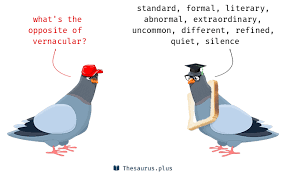 April 6
April 6
As this ordeal wears on, it’s harder and harder to know what the future is going to look like. The fear and uncertainly reverberate through our day like a continuous undertone. Sometimes, I wish I knew a lot of extraordinarily colorful curse words to scream at the uncaring distance. Which brings me to the vernacular. Lively language specific to someone’s background or locale can make a poem fresh and original. Vernacular is the baseball cap and bare feet of language, inviting you to come on in and set for a spell.
Poem: It’s hard to find a better example than C. D. Wright’s poem, “Our Dust.” You can listen to it read by the author, and read it’s amazing detail, filled with specifics from her background, Ozark Mountains of Arkansas. Note how the vernacular makes the poem a unique portrait.
Craft: For some reason this link makes you download the PDF of a Tony Hoagland essay – UCLA Extension. But it’s not a problem, because it’s worth keeping. There is another essay of his online from The Art of Voice, but it’s not as focused on today’s topic. The book is worth getting–it’s full of exercises that match each topic.
Prompt: I’ve always felt like “Our Dust” was a sort of obituary for C.D. Wright that she wrote herself, especially as is written in the past tense and ends with the retreat of the black car. Write your obituary today, using language specific to you, your own vernacular. Or if you don’t feel you have anything but plain English in your history, write an obituary of someone or thing that does have a specific language. There are even vernacular photos, snapshots by an anonymous shutterbug for which it’s unclear or unknown when, where, or with what type of camera the pictures were taken. If you have one of those, you might write about that.
Journal: The California Quarterly has no fee submissions and publishes four times a year. https://californiastatepoetrysociety.submittable.com/submit/140851/california-quarterly-guidelines
Recipe: The only recipe in my vernacular, that is, one that my mother (who was an anxious and awful cook), left me is creamy eggs. I make it in a double boiler that belonged to her. This recipe feeds two, but you can double as needed. Start by putting about an inch of water in the bottom of a double boiler ( you can use two pans if you don’t have a double boiler) over medium heat. Put about 2 teaspoons of butter in the top and let it melt while you beat three eggs, with a splash of milk, cream or yoghurt and a pinch of salt. Beat well. Crumble in a small chunk or large tablespoon of cream cheese. If you like, add some chives or other herb. Pour the eggs onto the melted butter, and stir as they firm up. I use a rubber spatula for this. When done to your taste, serve and eat.
Day 22
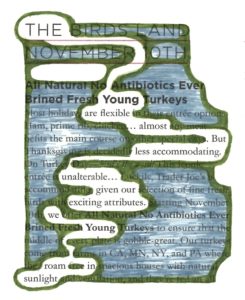 April 5
April 5
“Everything stated or expressed by man is note in the margin of a completely erased text.” Fernando Pessoa
So much of what used to be the furniture of our lives has just disappeared, erased. No going out for coffee with a friend, no parking by the beach, no browsing bookstores or borrowing a book from the library. So today’s theme is erasure. ( and I’m not talking about the English synth-pop duo, consisting of singer and songwriter Andy Bell and songwriter and keyboardist Vince Clarke.) More this kind: “Erasure poetry, also known as blackout poetry, is a form of found poetry wherein a poet takes an existing text and erases, blacks out, or otherwise obscures a large portion of the text, creating a wholly new work from what remains.
Erasure poetry may be used as a means of collaboration, creating a new text from an old one and thereby starting a dialogue between the two, or as a means of confrontation, a challenge to a pre-existing text.” from Ed Hirsch’s Poet’s Glossary
Poem: Mary Ruefle is perhaps the best know practitioner of this form, and we are lucky to be able to see one in total online. I say lucky, because most of her erasures are in the hands of collectors.
Craft: Mary Ruefle is also an articulate speaker on the form. Her craft talk on erasure is like an aria, it opens from a specific beginning into an inclusive discussion of this form. I especially love her erasure of her talk at the end. The written text of this talk is also online if you prefer.
Prompt: Find a text you want to erase, a page of newspaper, an old book, a map, a cereal box. Then begin using whiteout or tape or a black marker (or whatever) to create your erasure. Or use a poem of yours you are unhappy with. “Eight times out of ten an erasure of an original poem, made by the author of that poem, will be better than the original poem,” says Mary. Or it might be a great time to turn a text into a “viral,” a new form I just invented that talks about the virus without mentioning any of the words used about it.
Journal: SWIMM specializes in visual poetry, so you can submit your result here: https://swwim.submittable.com/submit/117680/visual-poetry-collage-poems-concrete-poems-erasures-etc I think they are only open to women-identifying writers.
Recipe: The Versatile Quesadilla or Soft Taco (10 minutes) Tortillas and cheese are the standard basis for this favorite meal. Flour or corn. I don’t even fold them. Even including these ingredients, you can add or leave out (erase) anything you can think of. If you’re keto, you can use a thin slice of turkey or ham, or a couple of broad, sturdy lettuce leaves. If you’re lactose intolerant, leave out the cheese!
The very simplest version of this: a corn tortilla with a little cheese, Mrs. Dash, and lime juice, my friend Jacki and I ate for breakfast, lunch, and dinner for the last two days of a camping trip along with the last of our fruit.
Day 21
 April 4
April 4
On the seventh day, even god rests. Time for revision! And though I don’t find revision restful, at least you should have something to work with by now.
Poem: Marianne Moore was famous for tinkering with her poems even after publication. For example, this poem, “Poetry,” became shorter and shorter, until her final version was “I too, dislike it.”
Craft: Poets Forum 2014 held a symposium with C. D. Wright, Juan Felipe Herrera, and Naomi Shihab Nye on the Art of Revision. It’s recorded in three separate segments, and while you may not find anything overwhelmingly helpful (is there anything other than hard work involved in revision?) you will at least be entertained.
Journal: AGNI magazine reads up to five poems at a time, and doesn’t charge for submissions. https://www.bu.edu/dbin/agni/
Recipe: This potato casserole is hearty and filling and makes great leftovers. Another form of revision.
Day 20
 April 3
April 3
Now that we are coming to terms with the fact that social distance will be a marathon, not over next Tuesday, and likely not a month from next Tuesday, I am thinking of it as a journey, a journey in which our best hope is that our beloved companions can navigate its passage safely. So it seems appropriate to focus on the haibun. Matsuo Bashō invented this form in the 17th century, using it as a travelog of his journey of 1500 miles across Japan, a formidable enterprise. He wrote his mediations on the trip in this form, a prose poem followed by a haiku that somehow summed it up. This form in English has many variations. For some, the haiku comes first, sometimes the haiku is implied. What’s essential is the quality of the work—a sort of explication (realistic or otherwise) and a pithy end.
Poem: Here are a few examples, each very different. I love the dreamlike elements of Aimee Nezhukumatathil’s Summer Haibun. It’s hard to beat an opening line like “To everything, there is a season of parrots.”
Brenda Hillman’s Crypto-animist Introvert Activism, a haibun, from Extra Hidden Life, among the Days, doesn’t look like a haibun. But the slightly off kilter final sentence is haikuish, syllabically 7-5-7, instead of of 5-7-5.
For another approach, you can dip into Robert Wilson’s Vietnam Ruminations.
Craft: This essay explains the tradition of the haibun. And this, again by Aimee Nezhukumatathil, gives another slant.
Prompt: Try writing your own haibun, they’re a lot of fun.
Journal: If you are successful, The Contemporary Haibun Online is open to submissions after May 1: https://contemporaryhaibunonline.com/
Recipe: I’ve never been clear on the difference between Japanese Gyoza and Potstickers. So here’s a recipe for whichever you want to call them. This one takes a bit of time. But a great way to procrastinate while you think about your haibun.
Day 19
April 2
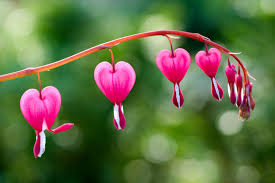 One of the hardest poems for me to write is the love poem. How hard? Let me count the ways:
One of the hardest poems for me to write is the love poem. How hard? Let me count the ways:
- Gushy, heartfelt, doggerel is always lurking
- When you’re in it the white heat of it, you are almost never interested in writing about it
- The complexities of love after white heat are hard to capture
- Almost all the words about love are already worn out
- Every pop song has already explored every nuance of love
I could go on, but you get the idea. So of course, today’s theme is the love poem.
Poem: Natalie Diaz is a particularly fierce writer, and her poem, “From the Desire Field” is a unique celebration of physical love: of both eros and spiritus, the passion of the body, the engagement of the spirit, that is so rare in love poetry. I especially love that she quotes Lorca’s “verde, que te quiero verde,” from “Romance Sonambulo,” one of the first non-English lines of poetry that captured me, a poem that sill vibrates today.
Another example at the end of this convoluted, backtracking, hesitant, and charming exposition by Li Young Lee is worth listening to for the longing he gets into the love poem he finally reads. He says he doesn’t have a title for it, but the first line would do, I think: “I loved you before I was born.”
Craft: Here are some explicit instructions from experts: Adrian Blevins, Rebecca Hoogs, Cyrus Cassells, and Craig Arnold on how to write love poems that don’t suck that include advice and samples.
Prompt: It must be obvious by now—your task is a love poem that that doesn’t suck! Easier said than done. But you have until next February 14th to finish it. Let’s hope we are through this by then!
Journal: Cultured Vultures spotlights both poetry and spoken word, so you could actually write a love song. https://culturedvultures.com/submit-poetry-free-poetry-submissions/
Recipe: A dessert of course! Something sweet.
Day 17
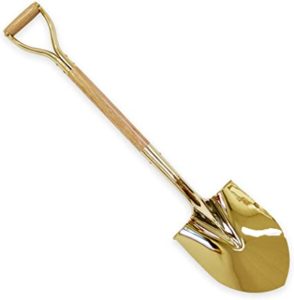 April 1
April 1
No April Fool’s here, especially with the confirmation of the extension of social isolation. On days like this, inspiration fails. That’s why I love form, especially form that builds on the work of others. As this is a continuation from Amanda Moore’s series, I thought I’d focus on the Golden Shovel, a form invented by Terrance Hayes in about 2010 that I first learned about from Amanda.
Poem: Terrance Hayes took a poem you probably know by Gwendolyn Brooks, “We Real Cool,” and created a masterful poem in two sections. Each line ends with a word from her poem, in order, and he credits the original poem. The first section, the section which shines as a poem in its own right, creates a new, updated version of that poem as it winds through lines that end with the original words, and like a good guide, the second section drives the form home.
Craft: This form took off, and became an anthology, The Golden Shovel Anthology: New Poems Honoring Gwendolyn Brooks. Thanks to Amazon you can “look inside” and read the Forward by Terrance Hayes and Introduction by the editors that explains the form and more.
Prompt: Your task for today is to create a poem using another poem as the stepping off point. It could be a Golden Shovel, a cento, or something of your own design. Here are the rules for the Golden Shovel:
- Use each word in the chosen line or lines as the end word for each line in your poem
- Use them in the order they appear in the original
- Credit the poet whose work you’re using
The problem with the form, of course, is that if you use a poem longer than “We Real Cool” or a haiku, your poem runs to pages and pages. So you might want to use just a stanza, or even a favorite line.
Journal: Palooka International Literary Magazine is a “a venue to give those writers and artists a truly fair shot at publication and the chance to be seen, read, and recognized—no connections, no solicitations, and only blind reading. Here, the quality of work is all that matters, not your demographics, who you know, where you come from, or what you’ve already accomplished. A fair chance and an open hand for everyone—the underdogs, the in-betweeners, and the already established.” So give them a try.
Recipe: I’ve always hated Kale Salad. But this one has a sweetness from the apple and raisins that makes it really a treat.
Day 16
March 31
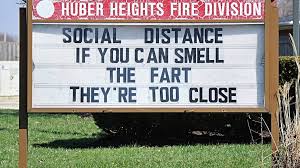 As everyone seems to need a little of it these days, I thought I’d start with a focus on humor. Hasn’t someone sent you something during this time that has made you laugh out loud? And didn’t you relish it and send it on to others? Today I’ll focus on poems that make you laugh, but also go deeper, a laugh that has some gravitas.
As everyone seems to need a little of it these days, I thought I’d start with a focus on humor. Hasn’t someone sent you something during this time that has made you laugh out loud? And didn’t you relish it and send it on to others? Today I’ll focus on poems that make you laugh, but also go deeper, a laugh that has some gravitas.
POEM: Many of Susan Browne’s poems have a wry wit. And Faith Is a Thing with Running Shoes seems appropriate for this moment. Of course,Billy Collins is one of the lightest hands here. He has dozens of poems that allow him “to be humorous without being silly.” Poems about marginalia, making a lanyard, the weather, but one of my favorites is Forgetfulness. There’s a charming little interview of him “pretending to be serious.”
CRAFT: For an unusual look at humor in Whitman, try Mark Doty’s essay. Or if you’d rather something other than a traditional craft talk, Anthony McCarten has a lovely, funny but meaningful Ted talk on humor that includes this line: “If we can laugh together we can live together.”
PROMPT: Write a poem that incorporates some humorous element, that surprises us with something that is revealed, that releases joy. Write something light that perhaps has some weight behind it.
JOURNAL: If you can do that, try entering it in the Winning Writers‘ annual contest for humous poems by April fool’s day: https://winningwriters.com/our-contests/wergle-flomp-humor-poetry-contest-free. Another possibility is the Adirondack Center for writing. They have a prompt and a submission process for “an April Fool’s joke goes terribly wrong.”
RECIPE: I’m going to enter a simple recipe every day here, but thought I’d start by inviting you to the Cooking School Taos online cooking classes. Chris Mahar is an amazing chef, and he and his wife Valerie have created an online experience that’s very affordable. As someone who channels her anxiety into cooking, I recommend it.
Day 15
March 30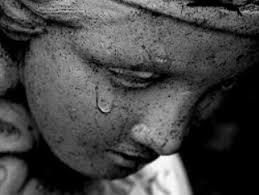
As the extension of the shelter in place edict to May 1 became official today. An article that resonated with me was one posted by the wonderful essayist and poet Heather Altfeld on Facebook and that Amanda Moore also posted on Day 11 of her series: “That Discomfort You’re Feeling is Grief,” by Scott Berinato, in the Harvard Business Review. Given that we are all grieving for the loss of normalcy, I thought today’s theme would be laments.
POEM: Anna Akhmatova lived in times so troubled they make our current dislocation seem very minor. She was one of a group of poets who came together in St. Petersburg in the first decade of the 20th century. Much like the imagist movement in the West, the Acmeist movement they formed sought to replace the flowery symbolism of the 19th century with “the word itself.” These young, rebellious, passionate poets endured revolution, WW I, Stalinism, WW II and the siege of Leningrad (St Petersburg’s new name) that was so severe many died of starvation. Akhmatova’s first husband was executed as a traitor, their son was imprisoned by Stalin; she was forced to write odes to Stalin for his release. Mandelstam, her close friend, died on his way to Siberia. Akhmatova lived under house arrest and her works were unpublished for decades. This is her Lament, read by her in Russian. Here is my translation (from Poems from the Stray Dog Cafe):
Ah, butI am warning you
This life’s the last I’m living through.
Not as a swallow, or a poplar
Not as a reed or a star,
Not as water from a well
Nor a bell’s hollow song—
I won’t return to trouble men
Or visit stranger’s dreams again
With my unquenchable lament.
Notice how the rhyme enhances the sorrowful quality of the lament, and how much grief is held in nine lines.
“Lament for the Makers” is a famous lament by William Dunbar, a 15th century Scottish Poet and Franciscan monk. You can see the original dedicated to famous poets. The Latin refrain translates as “Fear of death distresses me.” There have been dozens of reimaginings of this poem; here’s one by Joe Scanlan that honors 20th century architects and designers.
CRAFT: It’s hard to know how to engage subjects that feel beyond our control. Roger Reeves addresses this in his craft capsule on writing in a time of chaos. He is referencing acts of violence (Ferguson, Baltimore, Charleston). The virus. too, is a trauma that affects us all. His talk is relevant, especially the section on art performing the spectacle of going viral (no pun intended). “How often did we have to watch Erick Garner choke to death?” He speaks about how to create art that doesn’t feed the event but transcends it; how to engage without provoking what we seek to undo. In the case of the virus, how do we address what’s going on without feeding into the hysteria around it?
PROMPT: Write a lament for this period. It could be a lament for something you can’t do in lockdown, for a favorite restaurant or bookstore that may go out of business, for a time without this constant worry, for a loved one you can’t visit or an activity you miss. Experiment with rhyme, slant rhyme, alliteration, assonance to enhance the sorrow inherent in a lament—the hymn or ballad form: four line, four beat stanzas, particularly lends itself to lament: “Amazing Grace, how sweet the sound…” Sharon Olds has said that she recognizes that this form underlies her own work, though it wasn’t a conscious decision. Don’t be afraid to go over the top.
JOURNAL: If you are successful, the Bennington Review is in the midst of its reading period, and is looking for your innovative, intelligent, and moving poems. http://www.benningtonreview.org/submit They charge $24 for a subscription, but as I like the work, I think it’s worth it.
Recipe: Spaghetti with garlic, butter and herbs, the simplest comfort food:
Happy eating and writing.
Social/Distance Online Writing Retreat, Phase 2
The luminous and creative Amanda Moore started this series on March 16 (please visit), and I was so engaged by it, I asked her permission to do two weeks here at the end of her series. So this series will start on March 30. As I just heard Bill Gates say a full country lockdown for 6-10 weeks will be necessary to turn this around, it seems like we will need more than two weeks!
I plan to take Amanda’s basic format for each day: a theme, some sample poems, a craft talk and a journal submission suggestion, but I’m sure mine will evolve in a slightly different way. For one thing, I know a lot of poets who often don’t cook much are being challenged to make dinner every night, so I thought I’d include a simple recipe with each day’s poem. Also, I’m the queen of typos, so feel free to send me corrections, please!
Here was her introduction; I don’t think I have anything to add to it:
Poetry readings, book launches, and events have been called off to flatten the curve of COVID-19; sporting events have been cancelled or postponed, Broadway is closed, schools and university courses are being moved online, and we are all being urged to #StaytheFuckHome when we can (which sadly we all CAN’T). Can we really write poems at a time like this? Should we? I’m not sure, but I’m hoping to create a community space for it and see what happens—we all need art and poetry, and what better way to make it than together?